Impact of Janani Suraksha Yojana
VerifiedAdded on 2020/04/01
|17
|4619
|75
AI Summary
This assignment analyzes the effectiveness of India's Janani Suraksha Yojana (JSY), a conditional cash transfer program aimed at increasing institutional births and improving maternal health. It explores various aspects of the program, including its impact on family health behaviors, maternal health services utilization, and perceived advantages by beneficiaries. The analysis draws upon research articles, reports, and program documents to evaluate the JSY's contribution to safe motherhood in India.
Contribute Materials
Your contribution can guide someone’s learning journey. Share your
documents today.
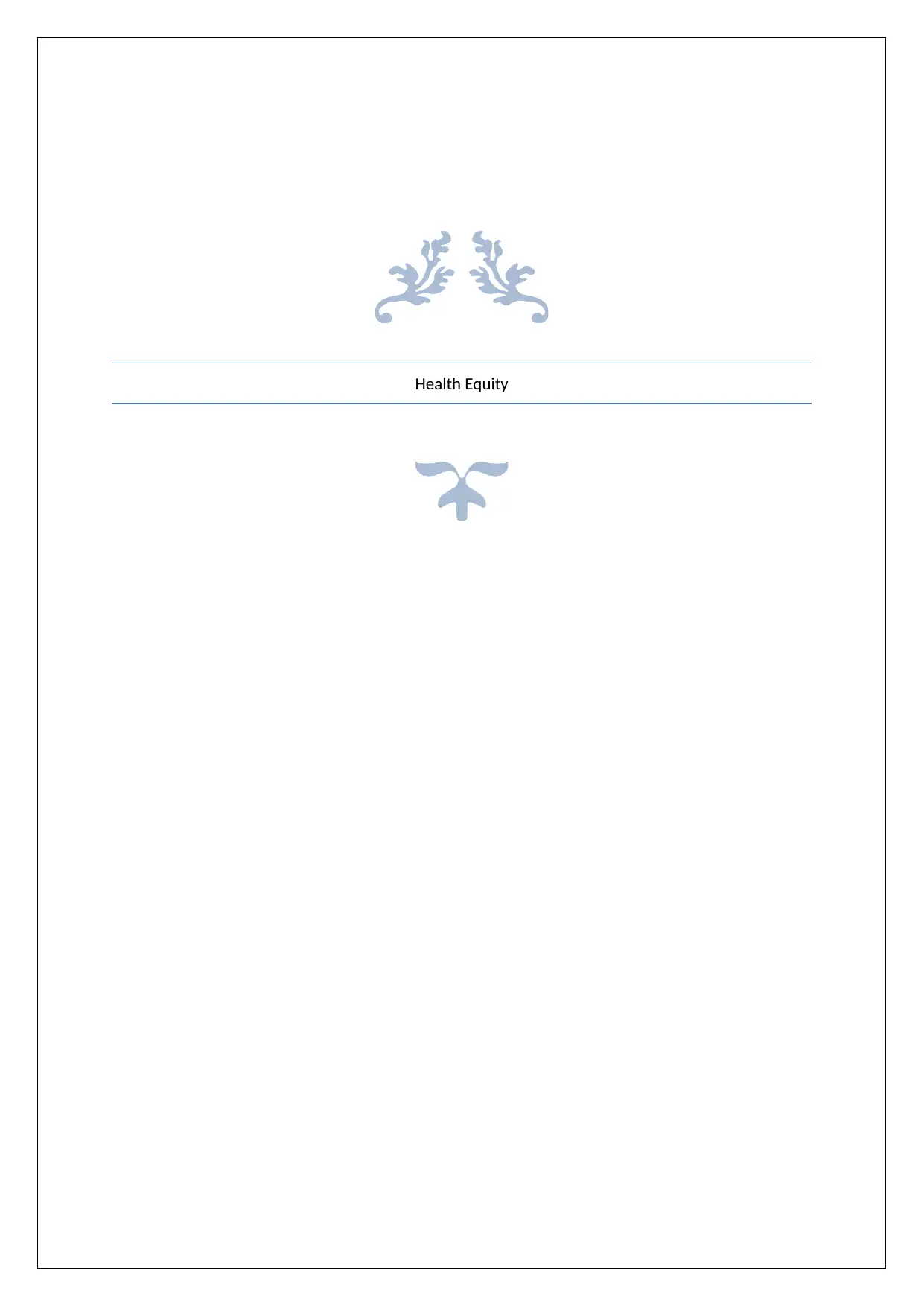
Health Equity
Secure Best Marks with AI Grader
Need help grading? Try our AI Grader for instant feedback on your assignments.
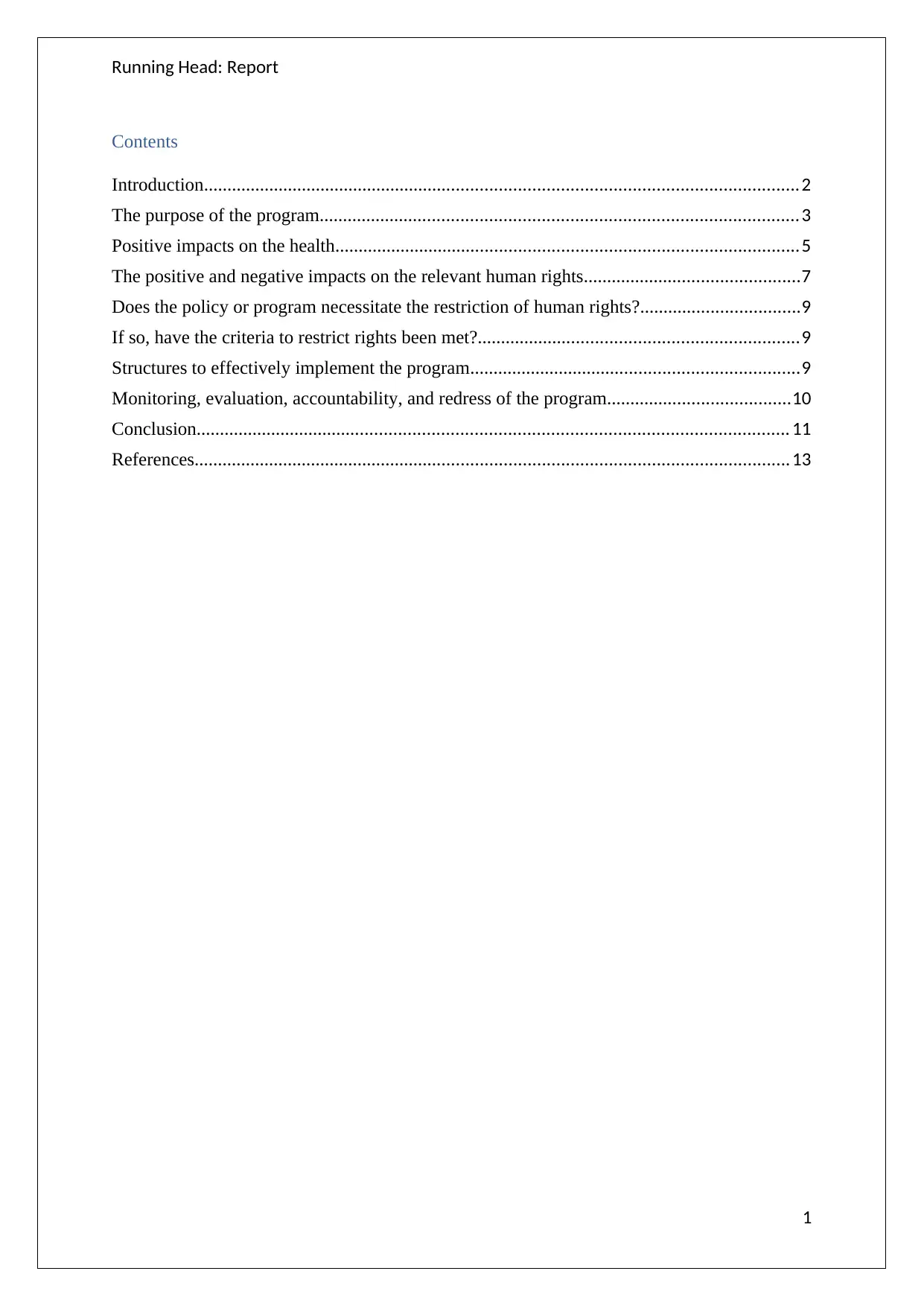
Running Head: Report
Contents
Introduction..............................................................................................................................2
The purpose of the program.....................................................................................................3
Positive impacts on the health..................................................................................................5
The positive and negative impacts on the relevant human rights..............................................7
Does the policy or program necessitate the restriction of human rights?..................................9
If so, have the criteria to restrict rights been met?....................................................................9
Structures to effectively implement the program......................................................................9
Monitoring, evaluation, accountability, and redress of the program.......................................10
Conclusion............................................................................................................................. 11
References.............................................................................................................................. 13
1
Contents
Introduction..............................................................................................................................2
The purpose of the program.....................................................................................................3
Positive impacts on the health..................................................................................................5
The positive and negative impacts on the relevant human rights..............................................7
Does the policy or program necessitate the restriction of human rights?..................................9
If so, have the criteria to restrict rights been met?....................................................................9
Structures to effectively implement the program......................................................................9
Monitoring, evaluation, accountability, and redress of the program.......................................10
Conclusion............................................................................................................................. 11
References.............................................................................................................................. 13
1
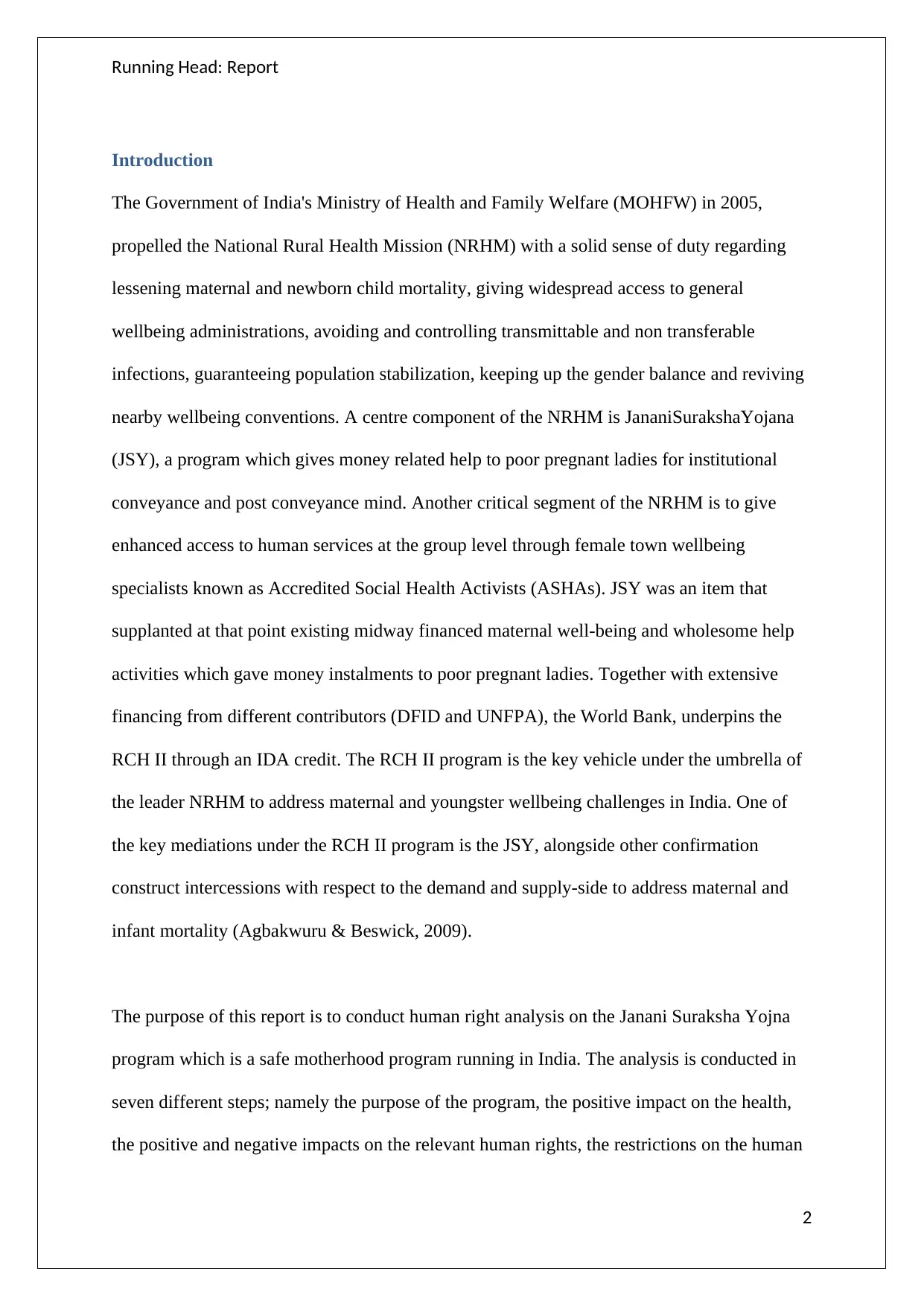
Running Head: Report
Introduction
The Government of India's Ministry of Health and Family Welfare (MOHFW) in 2005,
propelled the National Rural Health Mission (NRHM) with a solid sense of duty regarding
lessening maternal and newborn child mortality, giving widespread access to general
wellbeing administrations, avoiding and controlling transmittable and non transferable
infections, guaranteeing population stabilization, keeping up the gender balance and reviving
nearby wellbeing conventions. A centre component of the NRHM is JananiSurakshaYojana
(JSY), a program which gives money related help to poor pregnant ladies for institutional
conveyance and post conveyance mind. Another critical segment of the NRHM is to give
enhanced access to human services at the group level through female town wellbeing
specialists known as Accredited Social Health Activists (ASHAs). JSY was an item that
supplanted at that point existing midway financed maternal well-being and wholesome help
activities which gave money instalments to poor pregnant ladies. Together with extensive
financing from different contributors (DFID and UNFPA), the World Bank, underpins the
RCH II through an IDA credit. The RCH II program is the key vehicle under the umbrella of
the leader NRHM to address maternal and youngster wellbeing challenges in India. One of
the key mediations under the RCH II program is the JSY, alongside other confirmation
construct intercessions with respect to the demand and supply-side to address maternal and
infant mortality (Agbakwuru & Beswick, 2009).
The purpose of this report is to conduct human right analysis on the Janani Suraksha Yojna
program which is a safe motherhood program running in India. The analysis is conducted in
seven different steps; namely the purpose of the program, the positive impact on the health,
the positive and negative impacts on the relevant human rights, the restrictions on the human
2
Introduction
The Government of India's Ministry of Health and Family Welfare (MOHFW) in 2005,
propelled the National Rural Health Mission (NRHM) with a solid sense of duty regarding
lessening maternal and newborn child mortality, giving widespread access to general
wellbeing administrations, avoiding and controlling transmittable and non transferable
infections, guaranteeing population stabilization, keeping up the gender balance and reviving
nearby wellbeing conventions. A centre component of the NRHM is JananiSurakshaYojana
(JSY), a program which gives money related help to poor pregnant ladies for institutional
conveyance and post conveyance mind. Another critical segment of the NRHM is to give
enhanced access to human services at the group level through female town wellbeing
specialists known as Accredited Social Health Activists (ASHAs). JSY was an item that
supplanted at that point existing midway financed maternal well-being and wholesome help
activities which gave money instalments to poor pregnant ladies. Together with extensive
financing from different contributors (DFID and UNFPA), the World Bank, underpins the
RCH II through an IDA credit. The RCH II program is the key vehicle under the umbrella of
the leader NRHM to address maternal and youngster wellbeing challenges in India. One of
the key mediations under the RCH II program is the JSY, alongside other confirmation
construct intercessions with respect to the demand and supply-side to address maternal and
infant mortality (Agbakwuru & Beswick, 2009).
The purpose of this report is to conduct human right analysis on the Janani Suraksha Yojna
program which is a safe motherhood program running in India. The analysis is conducted in
seven different steps; namely the purpose of the program, the positive impact on the health,
the positive and negative impacts on the relevant human rights, the restrictions on the human
2
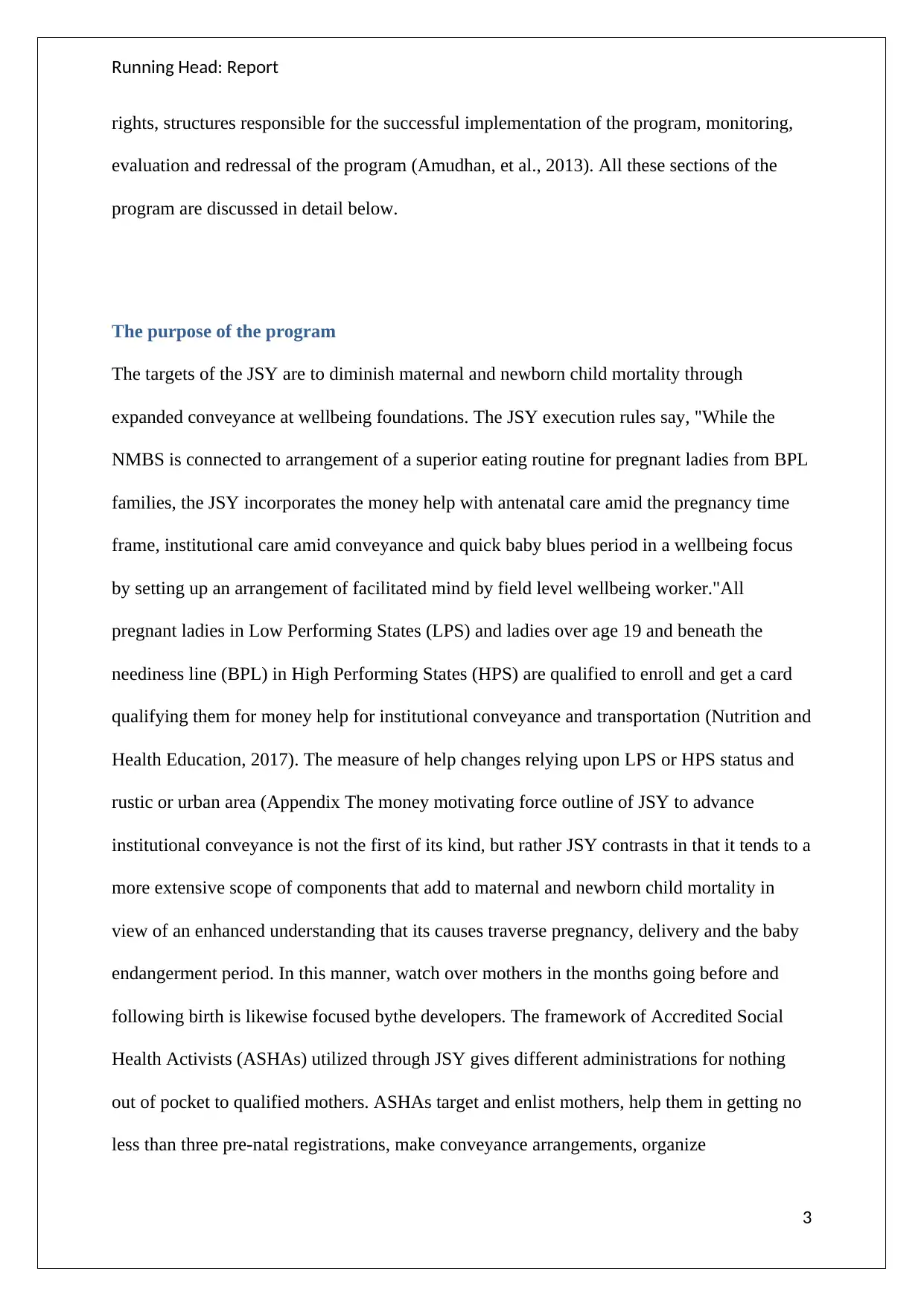
Running Head: Report
rights, structures responsible for the successful implementation of the program, monitoring,
evaluation and redressal of the program (Amudhan, et al., 2013). All these sections of the
program are discussed in detail below.
The purpose of the program
The targets of the JSY are to diminish maternal and newborn child mortality through
expanded conveyance at wellbeing foundations. The JSY execution rules say, "While the
NMBS is connected to arrangement of a superior eating routine for pregnant ladies from BPL
families, the JSY incorporates the money help with antenatal care amid the pregnancy time
frame, institutional care amid conveyance and quick baby blues period in a wellbeing focus
by setting up an arrangement of facilitated mind by field level wellbeing worker."All
pregnant ladies in Low Performing States (LPS) and ladies over age 19 and beneath the
neediness line (BPL) in High Performing States (HPS) are qualified to enroll and get a card
qualifying them for money help for institutional conveyance and transportation (Nutrition and
Health Education, 2017). The measure of help changes relying upon LPS or HPS status and
rustic or urban area (Appendix The money motivating force outline of JSY to advance
institutional conveyance is not the first of its kind, but rather JSY contrasts in that it tends to a
more extensive scope of components that add to maternal and newborn child mortality in
view of an enhanced understanding that its causes traverse pregnancy, delivery and the baby
endangerment period. In this manner, watch over mothers in the months going before and
following birth is likewise focused bythe developers. The framework of Accredited Social
Health Activists (ASHAs) utilized through JSY gives different administrations for nothing
out of pocket to qualified mothers. ASHAs target and enlist mothers, help them in getting no
less than three pre-natal registrations, make conveyance arrangements, organize
3
rights, structures responsible for the successful implementation of the program, monitoring,
evaluation and redressal of the program (Amudhan, et al., 2013). All these sections of the
program are discussed in detail below.
The purpose of the program
The targets of the JSY are to diminish maternal and newborn child mortality through
expanded conveyance at wellbeing foundations. The JSY execution rules say, "While the
NMBS is connected to arrangement of a superior eating routine for pregnant ladies from BPL
families, the JSY incorporates the money help with antenatal care amid the pregnancy time
frame, institutional care amid conveyance and quick baby blues period in a wellbeing focus
by setting up an arrangement of facilitated mind by field level wellbeing worker."All
pregnant ladies in Low Performing States (LPS) and ladies over age 19 and beneath the
neediness line (BPL) in High Performing States (HPS) are qualified to enroll and get a card
qualifying them for money help for institutional conveyance and transportation (Nutrition and
Health Education, 2017). The measure of help changes relying upon LPS or HPS status and
rustic or urban area (Appendix The money motivating force outline of JSY to advance
institutional conveyance is not the first of its kind, but rather JSY contrasts in that it tends to a
more extensive scope of components that add to maternal and newborn child mortality in
view of an enhanced understanding that its causes traverse pregnancy, delivery and the baby
endangerment period. In this manner, watch over mothers in the months going before and
following birth is likewise focused bythe developers. The framework of Accredited Social
Health Activists (ASHAs) utilized through JSY gives different administrations for nothing
out of pocket to qualified mothers. ASHAs target and enlist mothers, help them in getting no
less than three pre-natal registrations, make conveyance arrangements, organize
3
Secure Best Marks with AI Grader
Need help grading? Try our AI Grader for instant feedback on your assignments.
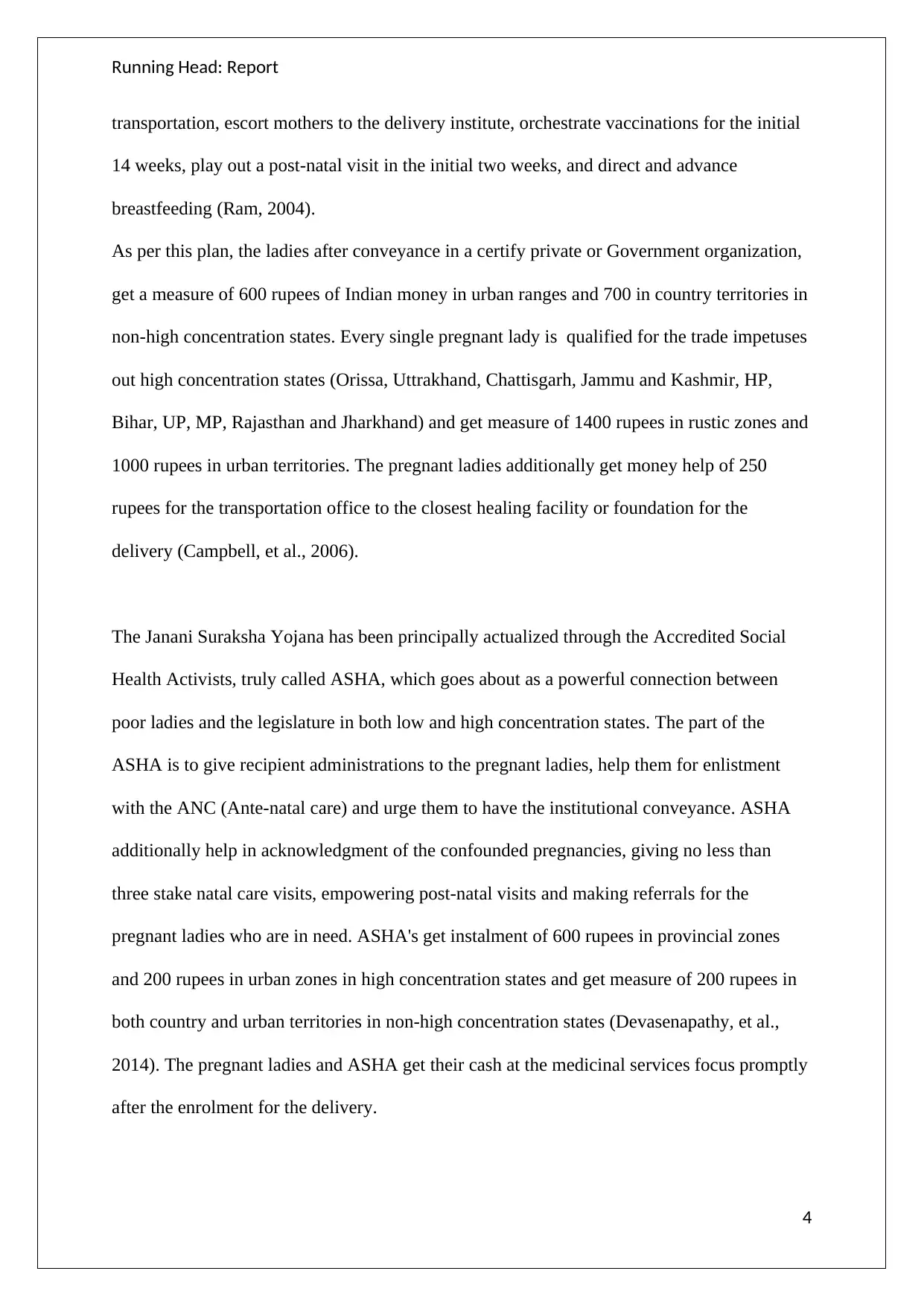
Running Head: Report
transportation, escort mothers to the delivery institute, orchestrate vaccinations for the initial
14 weeks, play out a post-natal visit in the initial two weeks, and direct and advance
breastfeeding (Ram, 2004).
As per this plan, the ladies after conveyance in a certify private or Government organization,
get a measure of 600 rupees of Indian money in urban ranges and 700 in country territories in
non-high concentration states. Every single pregnant lady is qualified for the trade impetuses
out high concentration states (Orissa, Uttrakhand, Chattisgarh, Jammu and Kashmir, HP,
Bihar, UP, MP, Rajasthan and Jharkhand) and get measure of 1400 rupees in rustic zones and
1000 rupees in urban territories. The pregnant ladies additionally get money help of 250
rupees for the transportation office to the closest healing facility or foundation for the
delivery (Campbell, et al., 2006).
The Janani Suraksha Yojana has been principally actualized through the Accredited Social
Health Activists, truly called ASHA, which goes about as a powerful connection between
poor ladies and the legislature in both low and high concentration states. The part of the
ASHA is to give recipient administrations to the pregnant ladies, help them for enlistment
with the ANC (Ante-natal care) and urge them to have the institutional conveyance. ASHA
additionally help in acknowledgment of the confounded pregnancies, giving no less than
three stake natal care visits, empowering post-natal visits and making referrals for the
pregnant ladies who are in need. ASHA's get instalment of 600 rupees in provincial zones
and 200 rupees in urban zones in high concentration states and get measure of 200 rupees in
both country and urban territories in non-high concentration states (Devasenapathy, et al.,
2014). The pregnant ladies and ASHA get their cash at the medicinal services focus promptly
after the enrolment for the delivery.
4
transportation, escort mothers to the delivery institute, orchestrate vaccinations for the initial
14 weeks, play out a post-natal visit in the initial two weeks, and direct and advance
breastfeeding (Ram, 2004).
As per this plan, the ladies after conveyance in a certify private or Government organization,
get a measure of 600 rupees of Indian money in urban ranges and 700 in country territories in
non-high concentration states. Every single pregnant lady is qualified for the trade impetuses
out high concentration states (Orissa, Uttrakhand, Chattisgarh, Jammu and Kashmir, HP,
Bihar, UP, MP, Rajasthan and Jharkhand) and get measure of 1400 rupees in rustic zones and
1000 rupees in urban territories. The pregnant ladies additionally get money help of 250
rupees for the transportation office to the closest healing facility or foundation for the
delivery (Campbell, et al., 2006).
The Janani Suraksha Yojana has been principally actualized through the Accredited Social
Health Activists, truly called ASHA, which goes about as a powerful connection between
poor ladies and the legislature in both low and high concentration states. The part of the
ASHA is to give recipient administrations to the pregnant ladies, help them for enlistment
with the ANC (Ante-natal care) and urge them to have the institutional conveyance. ASHA
additionally help in acknowledgment of the confounded pregnancies, giving no less than
three stake natal care visits, empowering post-natal visits and making referrals for the
pregnant ladies who are in need. ASHA's get instalment of 600 rupees in provincial zones
and 200 rupees in urban zones in high concentration states and get measure of 200 rupees in
both country and urban territories in non-high concentration states (Devasenapathy, et al.,
2014). The pregnant ladies and ASHA get their cash at the medicinal services focus promptly
after the enrolment for the delivery.
4
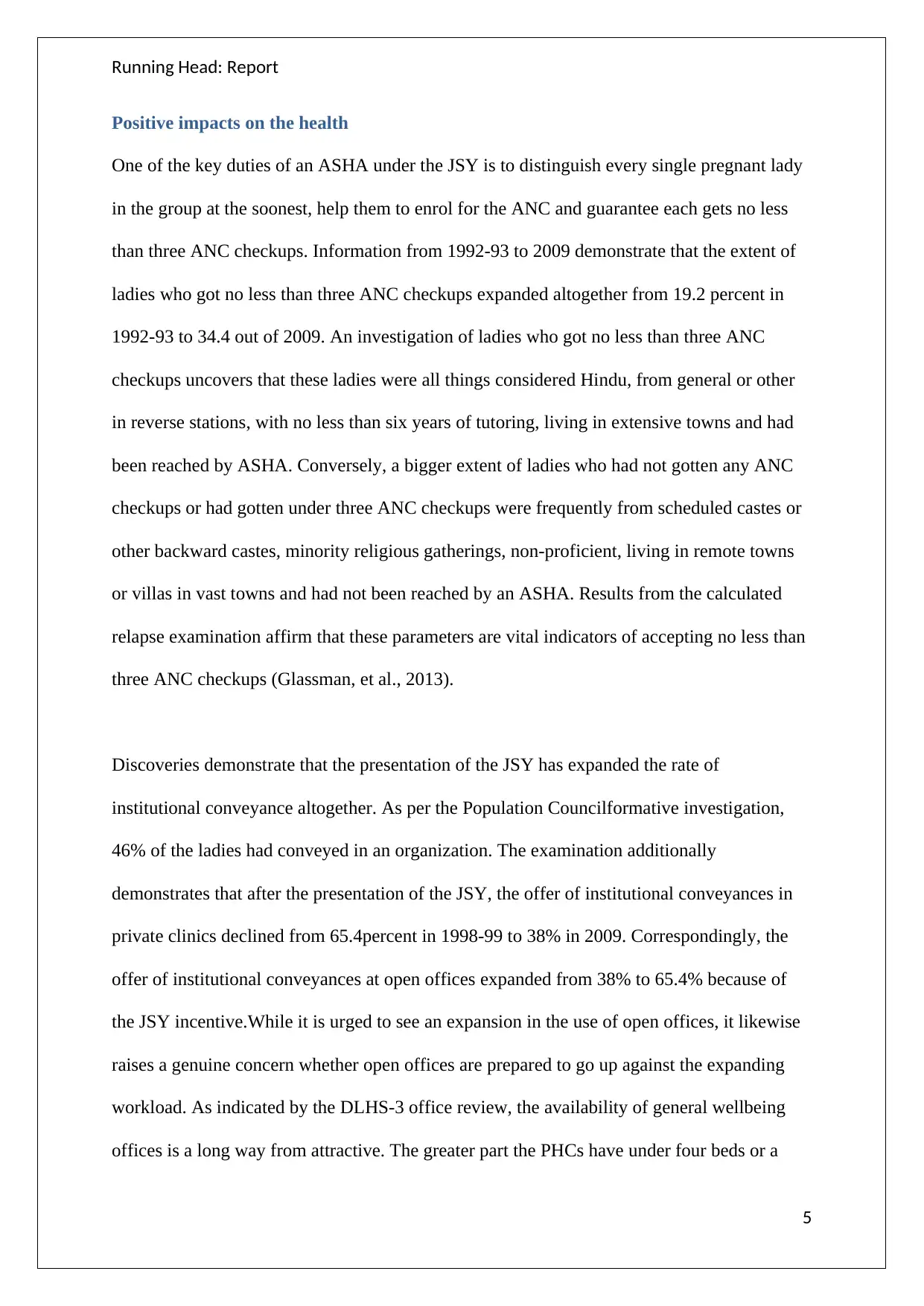
Running Head: Report
Positive impacts on the health
One of the key duties of an ASHA under the JSY is to distinguish every single pregnant lady
in the group at the soonest, help them to enrol for the ANC and guarantee each gets no less
than three ANC checkups. Information from 1992-93 to 2009 demonstrate that the extent of
ladies who got no less than three ANC checkups expanded altogether from 19.2 percent in
1992-93 to 34.4 out of 2009. An investigation of ladies who got no less than three ANC
checkups uncovers that these ladies were all things considered Hindu, from general or other
in reverse stations, with no less than six years of tutoring, living in extensive towns and had
been reached by ASHA. Conversely, a bigger extent of ladies who had not gotten any ANC
checkups or had gotten under three ANC checkups were frequently from scheduled castes or
other backward castes, minority religious gatherings, non-proficient, living in remote towns
or villas in vast towns and had not been reached by an ASHA. Results from the calculated
relapse examination affirm that these parameters are vital indicators of accepting no less than
three ANC checkups (Glassman, et al., 2013).
Discoveries demonstrate that the presentation of the JSY has expanded the rate of
institutional conveyance altogether. As per the Population Councilformative investigation,
46% of the ladies had conveyed in an organization. The examination additionally
demonstrates that after the presentation of the JSY, the offer of institutional conveyances in
private clinics declined from 65.4percent in 1998-99 to 38% in 2009. Correspondingly, the
offer of institutional conveyances at open offices expanded from 38% to 65.4% because of
the JSY incentive.While it is urged to see an expansion in the use of open offices, it likewise
raises a genuine concern whether open offices are prepared to go up against the expanding
workload. As indicated by the DLHS-3 office review, the availability of general wellbeing
offices is a long way from attractive. The greater part the PHCs have under four beds or a
5
Positive impacts on the health
One of the key duties of an ASHA under the JSY is to distinguish every single pregnant lady
in the group at the soonest, help them to enrol for the ANC and guarantee each gets no less
than three ANC checkups. Information from 1992-93 to 2009 demonstrate that the extent of
ladies who got no less than three ANC checkups expanded altogether from 19.2 percent in
1992-93 to 34.4 out of 2009. An investigation of ladies who got no less than three ANC
checkups uncovers that these ladies were all things considered Hindu, from general or other
in reverse stations, with no less than six years of tutoring, living in extensive towns and had
been reached by ASHA. Conversely, a bigger extent of ladies who had not gotten any ANC
checkups or had gotten under three ANC checkups were frequently from scheduled castes or
other backward castes, minority religious gatherings, non-proficient, living in remote towns
or villas in vast towns and had not been reached by an ASHA. Results from the calculated
relapse examination affirm that these parameters are vital indicators of accepting no less than
three ANC checkups (Glassman, et al., 2013).
Discoveries demonstrate that the presentation of the JSY has expanded the rate of
institutional conveyance altogether. As per the Population Councilformative investigation,
46% of the ladies had conveyed in an organization. The examination additionally
demonstrates that after the presentation of the JSY, the offer of institutional conveyances in
private clinics declined from 65.4percent in 1998-99 to 38% in 2009. Correspondingly, the
offer of institutional conveyances at open offices expanded from 38% to 65.4% because of
the JSY incentive.While it is urged to see an expansion in the use of open offices, it likewise
raises a genuine concern whether open offices are prepared to go up against the expanding
workload. As indicated by the DLHS-3 office review, the availability of general wellbeing
offices is a long way from attractive. The greater part the PHCs have under four beds or a
5
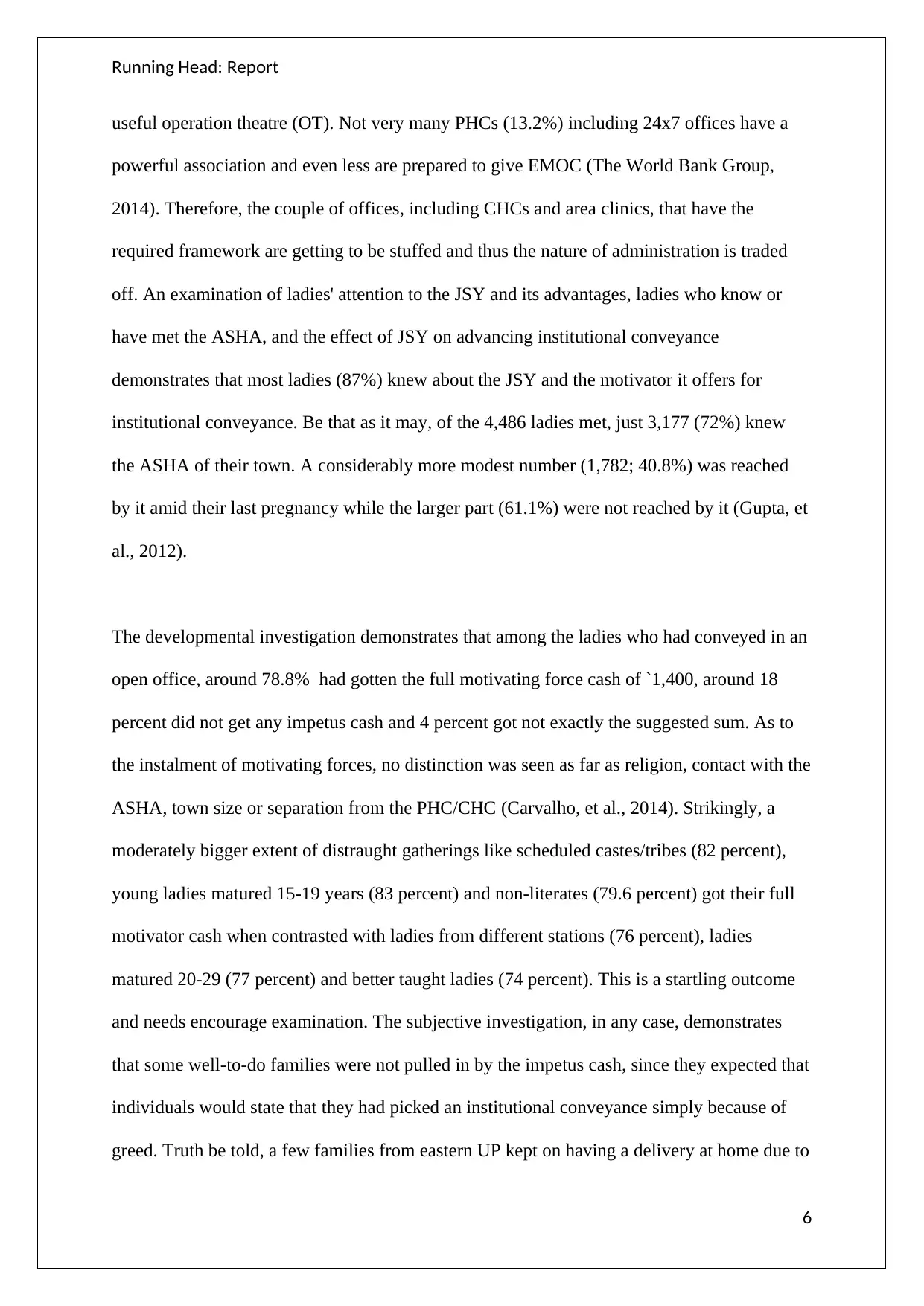
Running Head: Report
useful operation theatre (OT). Not very many PHCs (13.2%) including 24x7 offices have a
powerful association and even less are prepared to give EMOC (The World Bank Group,
2014). Therefore, the couple of offices, including CHCs and area clinics, that have the
required framework are getting to be stuffed and thus the nature of administration is traded
off. An examination of ladies' attention to the JSY and its advantages, ladies who know or
have met the ASHA, and the effect of JSY on advancing institutional conveyance
demonstrates that most ladies (87%) knew about the JSY and the motivator it offers for
institutional conveyance. Be that as it may, of the 4,486 ladies met, just 3,177 (72%) knew
the ASHA of their town. A considerably more modest number (1,782; 40.8%) was reached
by it amid their last pregnancy while the larger part (61.1%) were not reached by it (Gupta, et
al., 2012).
The developmental investigation demonstrates that among the ladies who had conveyed in an
open office, around 78.8% had gotten the full motivating force cash of `1,400, around 18
percent did not get any impetus cash and 4 percent got not exactly the suggested sum. As to
the instalment of motivating forces, no distinction was seen as far as religion, contact with the
ASHA, town size or separation from the PHC/CHC (Carvalho, et al., 2014). Strikingly, a
moderately bigger extent of distraught gatherings like scheduled castes/tribes (82 percent),
young ladies matured 15-19 years (83 percent) and non-literates (79.6 percent) got their full
motivator cash when contrasted with ladies from different stations (76 percent), ladies
matured 20-29 (77 percent) and better taught ladies (74 percent). This is a startling outcome
and needs encourage examination. The subjective investigation, in any case, demonstrates
that some well-to-do families were not pulled in by the impetus cash, since they expected that
individuals would state that they had picked an institutional conveyance simply because of
greed. Truth be told, a few families from eastern UP kept on having a delivery at home due to
6
useful operation theatre (OT). Not very many PHCs (13.2%) including 24x7 offices have a
powerful association and even less are prepared to give EMOC (The World Bank Group,
2014). Therefore, the couple of offices, including CHCs and area clinics, that have the
required framework are getting to be stuffed and thus the nature of administration is traded
off. An examination of ladies' attention to the JSY and its advantages, ladies who know or
have met the ASHA, and the effect of JSY on advancing institutional conveyance
demonstrates that most ladies (87%) knew about the JSY and the motivator it offers for
institutional conveyance. Be that as it may, of the 4,486 ladies met, just 3,177 (72%) knew
the ASHA of their town. A considerably more modest number (1,782; 40.8%) was reached
by it amid their last pregnancy while the larger part (61.1%) were not reached by it (Gupta, et
al., 2012).
The developmental investigation demonstrates that among the ladies who had conveyed in an
open office, around 78.8% had gotten the full motivating force cash of `1,400, around 18
percent did not get any impetus cash and 4 percent got not exactly the suggested sum. As to
the instalment of motivating forces, no distinction was seen as far as religion, contact with the
ASHA, town size or separation from the PHC/CHC (Carvalho, et al., 2014). Strikingly, a
moderately bigger extent of distraught gatherings like scheduled castes/tribes (82 percent),
young ladies matured 15-19 years (83 percent) and non-literates (79.6 percent) got their full
motivator cash when contrasted with ladies from different stations (76 percent), ladies
matured 20-29 (77 percent) and better taught ladies (74 percent). This is a startling outcome
and needs encourage examination. The subjective investigation, in any case, demonstrates
that some well-to-do families were not pulled in by the impetus cash, since they expected that
individuals would state that they had picked an institutional conveyance simply because of
greed. Truth be told, a few families from eastern UP kept on having a delivery at home due to
6
Paraphrase This Document
Need a fresh take? Get an instant paraphrase of this document with our AI Paraphraser

Running Head: Report
the same cause. In the event of western UP, the families with handsome income chose to go
to a private facility for the delivery procedure of their child (Sidney, et al., 2016).
The positive and negative impacts on the relevant human rights
The Millennium Development Goal 5 (MDG 5) primarily accentuated on moderating the
maternal mortality proportion by 5.5% every year by 2015. India alone in charge of around
28% of the worldwide neonatal passings saw in 2009. The fundamental components in charge
of this revile are lack of the logical conveyance rehearses performed by the untrained
specialists or truly called Dais and by locally accessible elderly ladies. Keeping in mind the
end goal to determine the issue, the Government of India (GOI) propelled a plan called
JananiSurakshaYogana-the sheltered parenthood program or mediation by the help of NRHM
in 2005. It implies the pregnant ladies wellbeing system or plan. JSY is the biggest
conditional cash transfer (CCT) conspire on the planet. The primary goal of the JSY program
is to diminish the maternal death rate by receiving the strategy for advancing the institutional
conveyances and by giving the quality care and support to the pregnant ladies (Kumar, et al.,
2012).
JananiSurakshaYojana scheme focuses on all the pregnant ladies who are 19 years old or
above, underneath the neediness line, from low and high performing states, from
scheduledtribes and standings . As indicated by the Ministry of wellbeing and Family
Welfare Scheme 2006, Women over the destitution line were excluded in this plan. Ladies
underneath the age of 19 years and who brought forth more than two live were qualified for
this plan. Confirmation recommends that the danger of mortality builds nine times in the
7
the same cause. In the event of western UP, the families with handsome income chose to go
to a private facility for the delivery procedure of their child (Sidney, et al., 2016).
The positive and negative impacts on the relevant human rights
The Millennium Development Goal 5 (MDG 5) primarily accentuated on moderating the
maternal mortality proportion by 5.5% every year by 2015. India alone in charge of around
28% of the worldwide neonatal passings saw in 2009. The fundamental components in charge
of this revile are lack of the logical conveyance rehearses performed by the untrained
specialists or truly called Dais and by locally accessible elderly ladies. Keeping in mind the
end goal to determine the issue, the Government of India (GOI) propelled a plan called
JananiSurakshaYogana-the sheltered parenthood program or mediation by the help of NRHM
in 2005. It implies the pregnant ladies wellbeing system or plan. JSY is the biggest
conditional cash transfer (CCT) conspire on the planet. The primary goal of the JSY program
is to diminish the maternal death rate by receiving the strategy for advancing the institutional
conveyances and by giving the quality care and support to the pregnant ladies (Kumar, et al.,
2012).
JananiSurakshaYojana scheme focuses on all the pregnant ladies who are 19 years old or
above, underneath the neediness line, from low and high performing states, from
scheduledtribes and standings . As indicated by the Ministry of wellbeing and Family
Welfare Scheme 2006, Women over the destitution line were excluded in this plan. Ladies
underneath the age of 19 years and who brought forth more than two live were qualified for
this plan. Confirmation recommends that the danger of mortality builds nine times in the
7

Running Head: Report
ladies underneath 19 years old and expands three times who are having more than two kids
(Furniturewalla, et al., 2015).
Rights impacted negatively by the JananiSurakshaYojana Scheme:
The ladies less than 19 years old years and bringing forth more than two kids are affected
adversely by this plan. Proof recommends that the danger of mortality expands nine times in
the ladies beneath 19 years old and builds three times who are having more than two
youngsters. This plan may be an oppression, but those ladies who are over the destitution line
and ladies who had two kids since they are not qualified to get the advantages of this
program. Because of these reasons, this plan has a portion of the negative effect on these
ladies. Proof demonstrates that the extent of the stake natal care visits is as yet not expanded
and there is likewise need in post-natal care offices (Barate & Temmerman, 2010).
Rights impacted positively by the JananiSurakshaYojana Scheme:
This plan puts a positive effect on the privileges of the ladies from the distinctive financial
status. It additionally affected emphatically on the privileges of the ladies from bringing
down planned standings and tribes. Jananisurakshayojana has ended up being viable to
advance the sex value and relieve the destitution rate. India has approved by the International
Covenant on common and political rights (ICCPR) which demonstrates that the rights to
value and uniformity and ideal against separation have accomplished its position in the
wellbeing situation (UNFPA, 2017). JSY additionally have positive effect on maternal and
newborn child wellbeing offices by change amid risk natal, natal and the post natal
administrations. Each pregnant lady has ideal to utilize the advantages of the protected
parenthood program. This plan puts a positive effect on the privilege against separation, ideal
8
ladies underneath 19 years old and expands three times who are having more than two kids
(Furniturewalla, et al., 2015).
Rights impacted negatively by the JananiSurakshaYojana Scheme:
The ladies less than 19 years old years and bringing forth more than two kids are affected
adversely by this plan. Proof recommends that the danger of mortality expands nine times in
the ladies beneath 19 years old and builds three times who are having more than two
youngsters. This plan may be an oppression, but those ladies who are over the destitution line
and ladies who had two kids since they are not qualified to get the advantages of this
program. Because of these reasons, this plan has a portion of the negative effect on these
ladies. Proof demonstrates that the extent of the stake natal care visits is as yet not expanded
and there is likewise need in post-natal care offices (Barate & Temmerman, 2010).
Rights impacted positively by the JananiSurakshaYojana Scheme:
This plan puts a positive effect on the privileges of the ladies from the distinctive financial
status. It additionally affected emphatically on the privileges of the ladies from bringing
down planned standings and tribes. Jananisurakshayojana has ended up being viable to
advance the sex value and relieve the destitution rate. India has approved by the International
Covenant on common and political rights (ICCPR) which demonstrates that the rights to
value and uniformity and ideal against separation have accomplished its position in the
wellbeing situation (UNFPA, 2017). JSY additionally have positive effect on maternal and
newborn child wellbeing offices by change amid risk natal, natal and the post natal
administrations. Each pregnant lady has ideal to utilize the advantages of the protected
parenthood program. This plan puts a positive effect on the privilege against separation, ideal
8

Running Head: Report
to value, appropriate to live with respect and the privilege to sex balance (Kumari, et al.,
2009).
Does the policy or program necessitate the restriction of human rights?
The safe motherhood program does not require the confinement of the human rights. There is
no commitment for any ladies to get enlist with the sheltered parenthood program. It is a
restrictive money plot, and the poor ladies get themselves enrolled through ASHA's to get the
advantages of the plan (Carvalho & Rokicki, 2013).
If so, have the criteria to restrict rights been met?
As there is no obligation for the human rights in this scheme, so this stage of human right
analysis cannot be assessed.
Structures to effectively implement the program
The cash conditional transfer program (CCT) in the safe motherhood program has been
observed to be fruitful in raising the utilization of the wellbeing administrations
predominantly from the lower level of the general wellbeing. Yet at the same time there is a
hole in the usage of the safe motherhood program. There are a few hindrances in its way to
obstruct its execution. The fundamental factor is the consciousness of this plan among the
pregnant ladies of India. The greater part of the ladies were ignorant of the program and its
advantages. The fundamental driver of this slack was the absence of data about the plan and
also the lack if proper instructions (Khan, et al., 2010).
9
to value, appropriate to live with respect and the privilege to sex balance (Kumari, et al.,
2009).
Does the policy or program necessitate the restriction of human rights?
The safe motherhood program does not require the confinement of the human rights. There is
no commitment for any ladies to get enlist with the sheltered parenthood program. It is a
restrictive money plot, and the poor ladies get themselves enrolled through ASHA's to get the
advantages of the plan (Carvalho & Rokicki, 2013).
If so, have the criteria to restrict rights been met?
As there is no obligation for the human rights in this scheme, so this stage of human right
analysis cannot be assessed.
Structures to effectively implement the program
The cash conditional transfer program (CCT) in the safe motherhood program has been
observed to be fruitful in raising the utilization of the wellbeing administrations
predominantly from the lower level of the general wellbeing. Yet at the same time there is a
hole in the usage of the safe motherhood program. There are a few hindrances in its way to
obstruct its execution. The fundamental factor is the consciousness of this plan among the
pregnant ladies of India. The greater part of the ladies were ignorant of the program and its
advantages. The fundamental driver of this slack was the absence of data about the plan and
also the lack if proper instructions (Khan, et al., 2010).
9
Secure Best Marks with AI Grader
Need help grading? Try our AI Grader for instant feedback on your assignments.
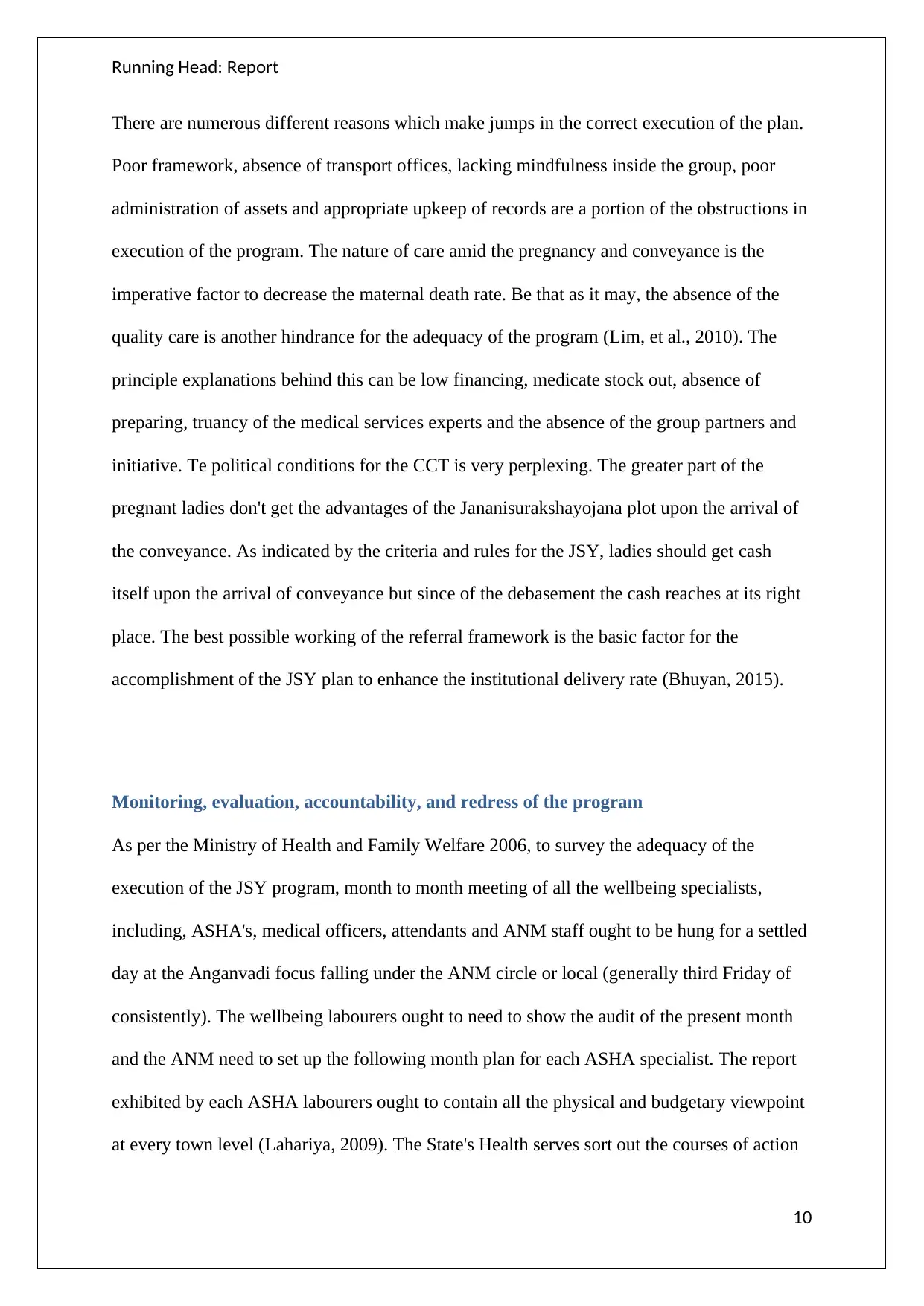
Running Head: Report
There are numerous different reasons which make jumps in the correct execution of the plan.
Poor framework, absence of transport offices, lacking mindfulness inside the group, poor
administration of assets and appropriate upkeep of records are a portion of the obstructions in
execution of the program. The nature of care amid the pregnancy and conveyance is the
imperative factor to decrease the maternal death rate. Be that as it may, the absence of the
quality care is another hindrance for the adequacy of the program (Lim, et al., 2010). The
principle explanations behind this can be low financing, medicate stock out, absence of
preparing, truancy of the medical services experts and the absence of the group partners and
initiative. Te political conditions for the CCT is very perplexing. The greater part of the
pregnant ladies don't get the advantages of the Jananisurakshayojana plot upon the arrival of
the conveyance. As indicated by the criteria and rules for the JSY, ladies should get cash
itself upon the arrival of conveyance but since of the debasement the cash reaches at its right
place. The best possible working of the referral framework is the basic factor for the
accomplishment of the JSY plan to enhance the institutional delivery rate (Bhuyan, 2015).
Monitoring, evaluation, accountability, and redress of the program
As per the Ministry of Health and Family Welfare 2006, to survey the adequacy of the
execution of the JSY program, month to month meeting of all the wellbeing specialists,
including, ASHA's, medical officers, attendants and ANM staff ought to be hung for a settled
day at the Anganvadi focus falling under the ANM circle or local (generally third Friday of
consistently). The wellbeing labourers ought to need to show the audit of the present month
and the ANM need to set up the following month plan for each ASHA specialist. The report
exhibited by each ASHA labourers ought to contain all the physical and budgetary viewpoint
at every town level (Lahariya, 2009). The State's Health serves sort out the courses of action
10
There are numerous different reasons which make jumps in the correct execution of the plan.
Poor framework, absence of transport offices, lacking mindfulness inside the group, poor
administration of assets and appropriate upkeep of records are a portion of the obstructions in
execution of the program. The nature of care amid the pregnancy and conveyance is the
imperative factor to decrease the maternal death rate. Be that as it may, the absence of the
quality care is another hindrance for the adequacy of the program (Lim, et al., 2010). The
principle explanations behind this can be low financing, medicate stock out, absence of
preparing, truancy of the medical services experts and the absence of the group partners and
initiative. Te political conditions for the CCT is very perplexing. The greater part of the
pregnant ladies don't get the advantages of the Jananisurakshayojana plot upon the arrival of
the conveyance. As indicated by the criteria and rules for the JSY, ladies should get cash
itself upon the arrival of conveyance but since of the debasement the cash reaches at its right
place. The best possible working of the referral framework is the basic factor for the
accomplishment of the JSY plan to enhance the institutional delivery rate (Bhuyan, 2015).
Monitoring, evaluation, accountability, and redress of the program
As per the Ministry of Health and Family Welfare 2006, to survey the adequacy of the
execution of the JSY program, month to month meeting of all the wellbeing specialists,
including, ASHA's, medical officers, attendants and ANM staff ought to be hung for a settled
day at the Anganvadi focus falling under the ANM circle or local (generally third Friday of
consistently). The wellbeing labourers ought to need to show the audit of the present month
and the ANM need to set up the following month plan for each ASHA specialist. The report
exhibited by each ASHA labourers ought to contain all the physical and budgetary viewpoint
at every town level (Lahariya, 2009). The State's Health serves sort out the courses of action
10
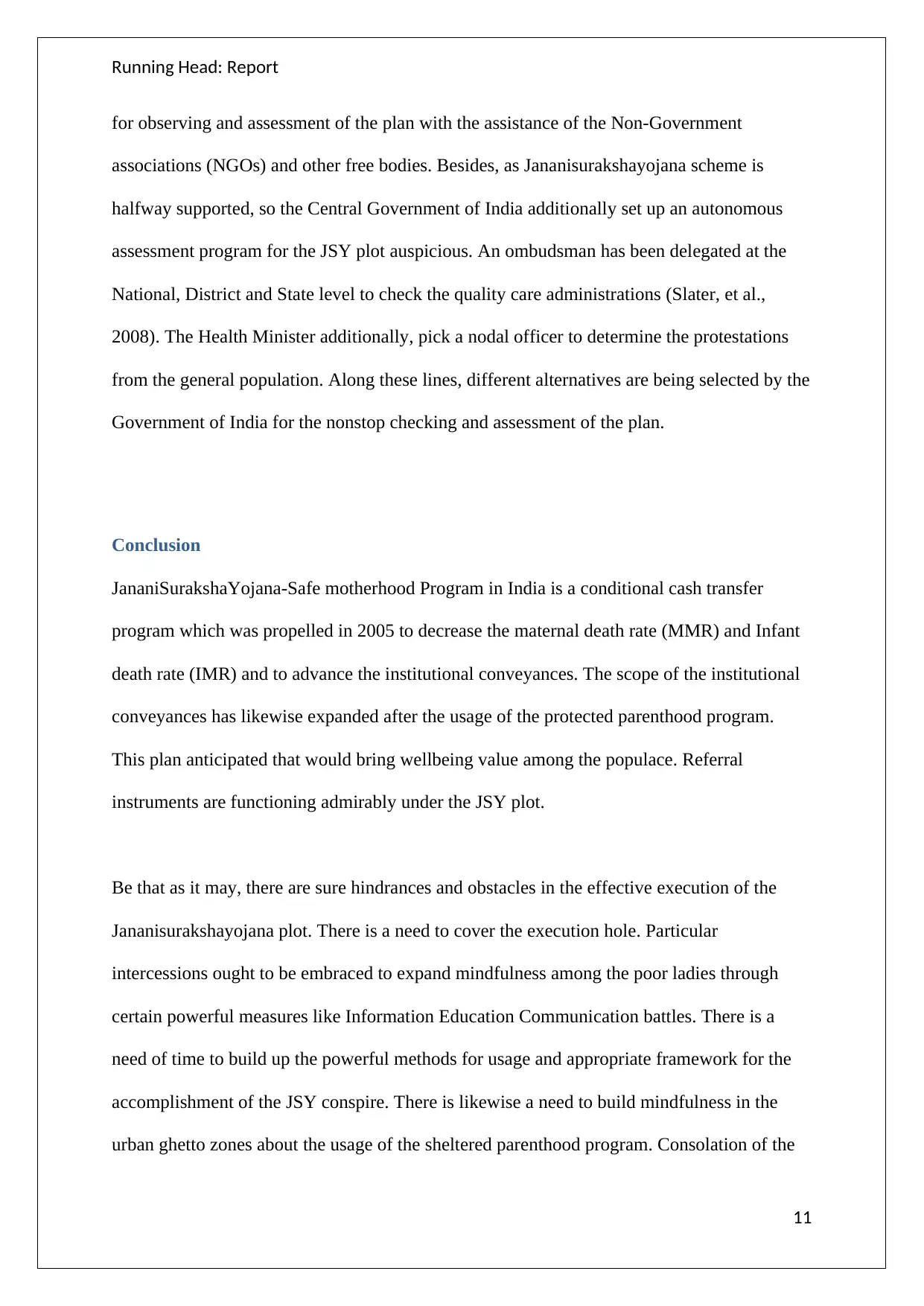
Running Head: Report
for observing and assessment of the plan with the assistance of the Non-Government
associations (NGOs) and other free bodies. Besides, as Jananisurakshayojana scheme is
halfway supported, so the Central Government of India additionally set up an autonomous
assessment program for the JSY plot auspicious. An ombudsman has been delegated at the
National, District and State level to check the quality care administrations (Slater, et al.,
2008). The Health Minister additionally, pick a nodal officer to determine the protestations
from the general population. Along these lines, different alternatives are being selected by the
Government of India for the nonstop checking and assessment of the plan.
Conclusion
JananiSurakshaYojana-Safe motherhood Program in India is a conditional cash transfer
program which was propelled in 2005 to decrease the maternal death rate (MMR) and Infant
death rate (IMR) and to advance the institutional conveyances. The scope of the institutional
conveyances has likewise expanded after the usage of the protected parenthood program.
This plan anticipated that would bring wellbeing value among the populace. Referral
instruments are functioning admirably under the JSY plot.
Be that as it may, there are sure hindrances and obstacles in the effective execution of the
Jananisurakshayojana plot. There is a need to cover the execution hole. Particular
intercessions ought to be embraced to expand mindfulness among the poor ladies through
certain powerful measures like Information Education Communication battles. There is a
need of time to build up the powerful methods for usage and appropriate framework for the
accomplishment of the JSY conspire. There is likewise a need to build mindfulness in the
urban ghetto zones about the usage of the sheltered parenthood program. Consolation of the
11
for observing and assessment of the plan with the assistance of the Non-Government
associations (NGOs) and other free bodies. Besides, as Jananisurakshayojana scheme is
halfway supported, so the Central Government of India additionally set up an autonomous
assessment program for the JSY plot auspicious. An ombudsman has been delegated at the
National, District and State level to check the quality care administrations (Slater, et al.,
2008). The Health Minister additionally, pick a nodal officer to determine the protestations
from the general population. Along these lines, different alternatives are being selected by the
Government of India for the nonstop checking and assessment of the plan.
Conclusion
JananiSurakshaYojana-Safe motherhood Program in India is a conditional cash transfer
program which was propelled in 2005 to decrease the maternal death rate (MMR) and Infant
death rate (IMR) and to advance the institutional conveyances. The scope of the institutional
conveyances has likewise expanded after the usage of the protected parenthood program.
This plan anticipated that would bring wellbeing value among the populace. Referral
instruments are functioning admirably under the JSY plot.
Be that as it may, there are sure hindrances and obstacles in the effective execution of the
Jananisurakshayojana plot. There is a need to cover the execution hole. Particular
intercessions ought to be embraced to expand mindfulness among the poor ladies through
certain powerful measures like Information Education Communication battles. There is a
need of time to build up the powerful methods for usage and appropriate framework for the
accomplishment of the JSY conspire. There is likewise a need to build mindfulness in the
urban ghetto zones about the usage of the sheltered parenthood program. Consolation of the
11

Running Head: Report
more risk natal visit, and uncommon measures for the conveyances are required to improve
the effect of the JananiSurakshaYojana. Healing facility remain after the conveyance ought to
be over two days to diminish the odds of contamination in the mother and the infant. The
social and monetary interest in the proficiency of the ladies additionally put constructive
outcome in the accomplishment of the plan. Appropriate interest in the JSY plot without
debasement is the basic stride to accomplish the Millenium Development Goals 4 and 5
(MDG 4 and 5). Maternal and Infant wellbeing are the indicators of the nation's wellbeing
framework, so it can be accomplished by means of appropriate execution of JSY.
12
more risk natal visit, and uncommon measures for the conveyances are required to improve
the effect of the JananiSurakshaYojana. Healing facility remain after the conveyance ought to
be over two days to diminish the odds of contamination in the mother and the infant. The
social and monetary interest in the proficiency of the ladies additionally put constructive
outcome in the accomplishment of the plan. Appropriate interest in the JSY plot without
debasement is the basic stride to accomplish the Millenium Development Goals 4 and 5
(MDG 4 and 5). Maternal and Infant wellbeing are the indicators of the nation's wellbeing
framework, so it can be accomplished by means of appropriate execution of JSY.
12
Paraphrase This Document
Need a fresh take? Get an instant paraphrase of this document with our AI Paraphraser
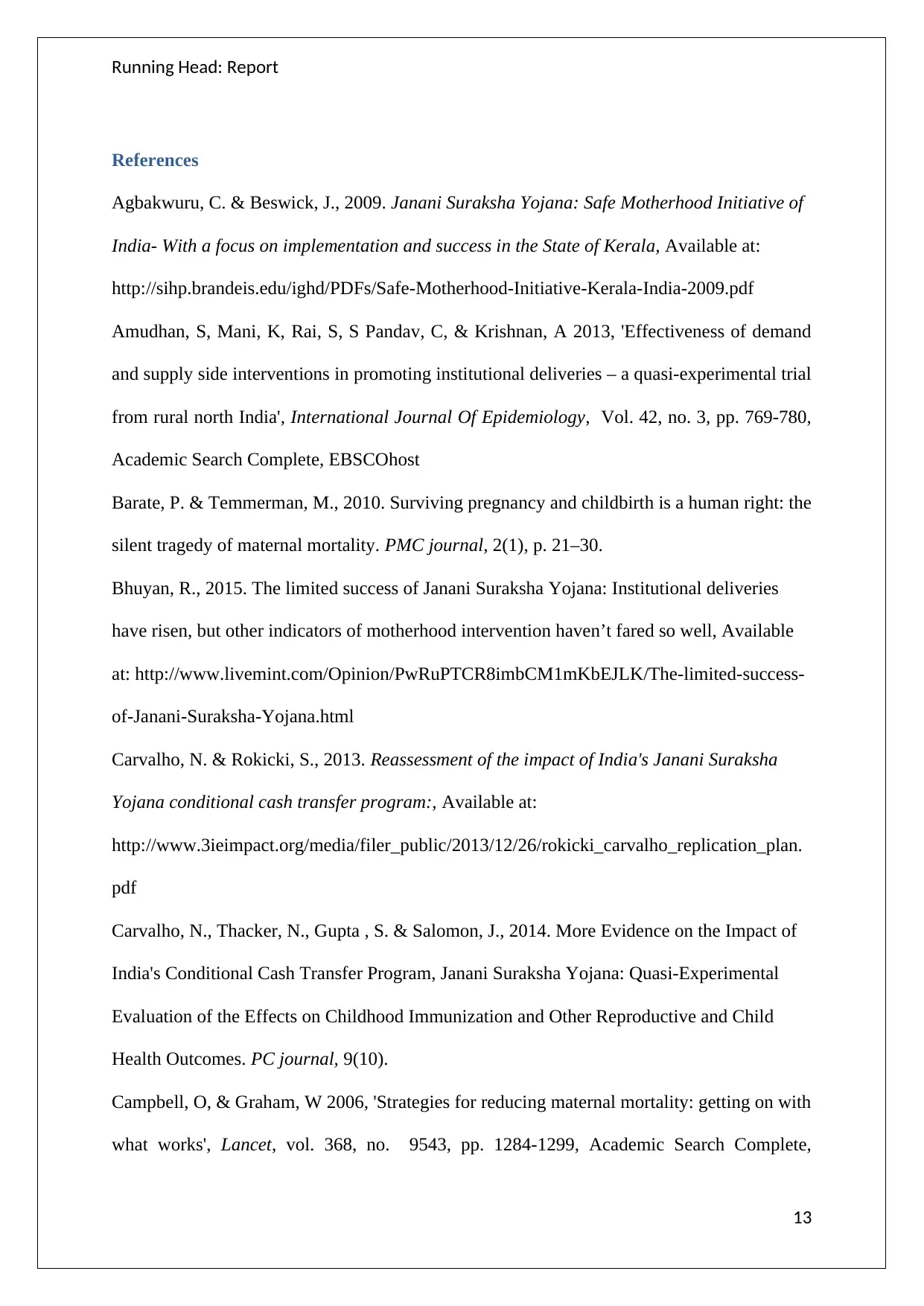
Running Head: Report
References
Agbakwuru, C. & Beswick, J., 2009. Janani Suraksha Yojana: Safe Motherhood Initiative of
India- With a focus on implementation and success in the State of Kerala, Available at:
http://sihp.brandeis.edu/ighd/PDFs/Safe-Motherhood-Initiative-Kerala-India-2009.pdf
Amudhan, S, Mani, K, Rai, S, S Pandav, C, & Krishnan, A 2013, 'Effectiveness of demand
and supply side interventions in promoting institutional deliveries – a quasi-experimental trial
from rural north India', International Journal Of Epidemiology, Vol. 42, no. 3, pp. 769-780,
Academic Search Complete, EBSCOhost
Barate, P. & Temmerman, M., 2010. Surviving pregnancy and childbirth is a human right: the
silent tragedy of maternal mortality. PMC journal, 2(1), p. 21–30.
Bhuyan, R., 2015. The limited success of Janani Suraksha Yojana: Institutional deliveries
have risen, but other indicators of motherhood intervention haven’t fared so well, Available
at: http://www.livemint.com/Opinion/PwRuPTCR8imbCM1mKbEJLK/The-limited-success-
of-Janani-Suraksha-Yojana.html
Carvalho, N. & Rokicki, S., 2013. Reassessment of the impact of India's Janani Suraksha
Yojana conditional cash transfer program:, Available at:
http://www.3ieimpact.org/media/filer_public/2013/12/26/rokicki_carvalho_replication_plan.
pdf
Carvalho, N., Thacker, N., Gupta , S. & Salomon, J., 2014. More Evidence on the Impact of
India's Conditional Cash Transfer Program, Janani Suraksha Yojana: Quasi-Experimental
Evaluation of the Effects on Childhood Immunization and Other Reproductive and Child
Health Outcomes. PC journal, 9(10).
Campbell, O, & Graham, W 2006, 'Strategies for reducing maternal mortality: getting on with
what works', Lancet, vol. 368, no. 9543, pp. 1284-1299, Academic Search Complete,
13
References
Agbakwuru, C. & Beswick, J., 2009. Janani Suraksha Yojana: Safe Motherhood Initiative of
India- With a focus on implementation and success in the State of Kerala, Available at:
http://sihp.brandeis.edu/ighd/PDFs/Safe-Motherhood-Initiative-Kerala-India-2009.pdf
Amudhan, S, Mani, K, Rai, S, S Pandav, C, & Krishnan, A 2013, 'Effectiveness of demand
and supply side interventions in promoting institutional deliveries – a quasi-experimental trial
from rural north India', International Journal Of Epidemiology, Vol. 42, no. 3, pp. 769-780,
Academic Search Complete, EBSCOhost
Barate, P. & Temmerman, M., 2010. Surviving pregnancy and childbirth is a human right: the
silent tragedy of maternal mortality. PMC journal, 2(1), p. 21–30.
Bhuyan, R., 2015. The limited success of Janani Suraksha Yojana: Institutional deliveries
have risen, but other indicators of motherhood intervention haven’t fared so well, Available
at: http://www.livemint.com/Opinion/PwRuPTCR8imbCM1mKbEJLK/The-limited-success-
of-Janani-Suraksha-Yojana.html
Carvalho, N. & Rokicki, S., 2013. Reassessment of the impact of India's Janani Suraksha
Yojana conditional cash transfer program:, Available at:
http://www.3ieimpact.org/media/filer_public/2013/12/26/rokicki_carvalho_replication_plan.
Carvalho, N., Thacker, N., Gupta , S. & Salomon, J., 2014. More Evidence on the Impact of
India's Conditional Cash Transfer Program, Janani Suraksha Yojana: Quasi-Experimental
Evaluation of the Effects on Childhood Immunization and Other Reproductive and Child
Health Outcomes. PC journal, 9(10).
Campbell, O, & Graham, W 2006, 'Strategies for reducing maternal mortality: getting on with
what works', Lancet, vol. 368, no. 9543, pp. 1284-1299, Academic Search Complete,
13
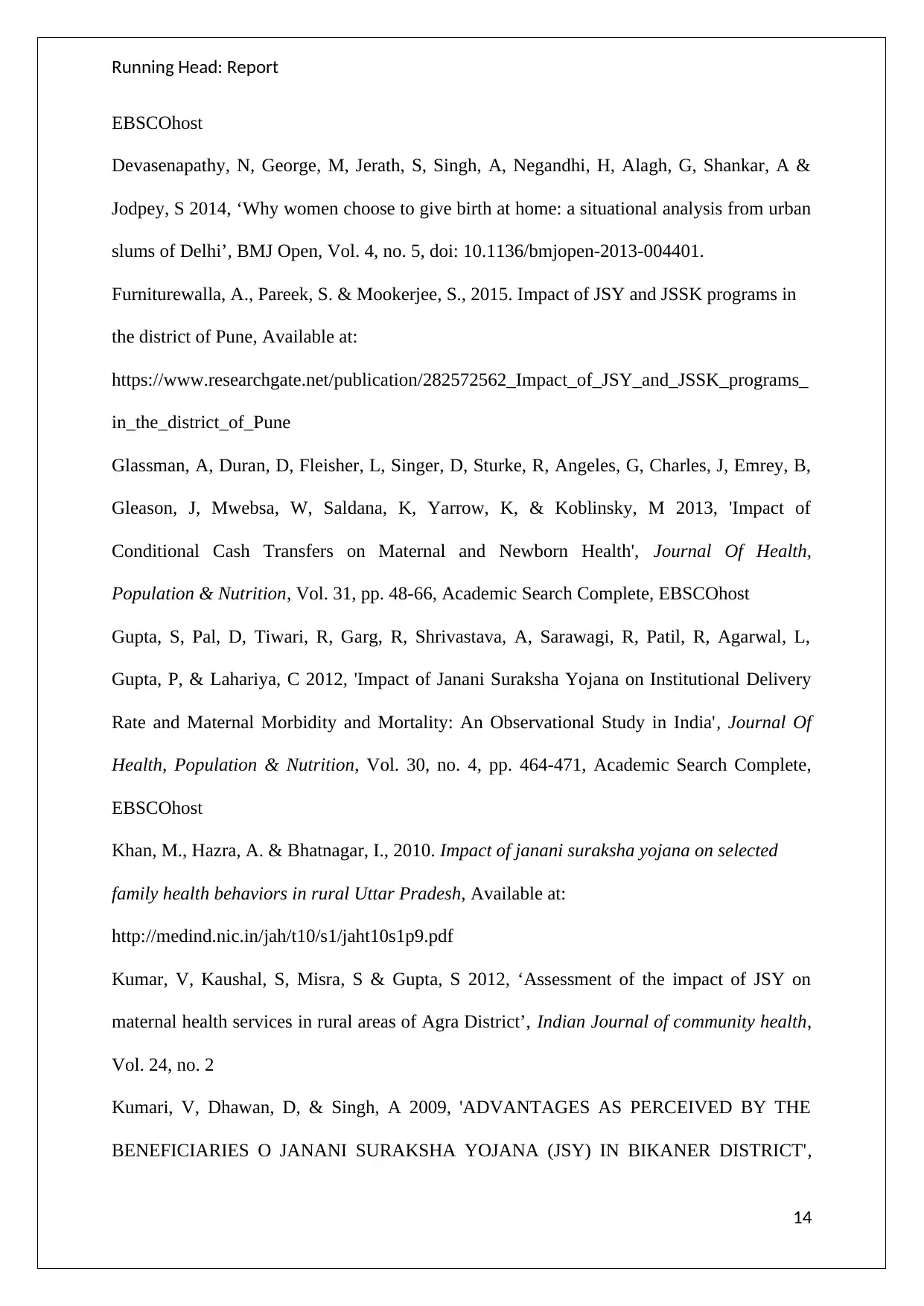
Running Head: Report
EBSCOhost
Devasenapathy, N, George, M, Jerath, S, Singh, A, Negandhi, H, Alagh, G, Shankar, A &
Jodpey, S 2014, ‘Why women choose to give birth at home: a situational analysis from urban
slums of Delhi’, BMJ Open, Vol. 4, no. 5, doi: 10.1136/bmjopen-2013-004401.
Furniturewalla, A., Pareek, S. & Mookerjee, S., 2015. Impact of JSY and JSSK programs in
the district of Pune, Available at:
https://www.researchgate.net/publication/282572562_Impact_of_JSY_and_JSSK_programs_
in_the_district_of_Pune
Glassman, A, Duran, D, Fleisher, L, Singer, D, Sturke, R, Angeles, G, Charles, J, Emrey, B,
Gleason, J, Mwebsa, W, Saldana, K, Yarrow, K, & Koblinsky, M 2013, 'Impact of
Conditional Cash Transfers on Maternal and Newborn Health', Journal Of Health,
Population & Nutrition, Vol. 31, pp. 48-66, Academic Search Complete, EBSCOhost
Gupta, S, Pal, D, Tiwari, R, Garg, R, Shrivastava, A, Sarawagi, R, Patil, R, Agarwal, L,
Gupta, P, & Lahariya, C 2012, 'Impact of Janani Suraksha Yojana on Institutional Delivery
Rate and Maternal Morbidity and Mortality: An Observational Study in India', Journal Of
Health, Population & Nutrition, Vol. 30, no. 4, pp. 464-471, Academic Search Complete,
EBSCOhost
Khan, M., Hazra, A. & Bhatnagar, I., 2010. Impact of janani suraksha yojana on selected
family health behaviors in rural Uttar Pradesh, Available at:
http://medind.nic.in/jah/t10/s1/jaht10s1p9.pdf
Kumar, V, Kaushal, S, Misra, S & Gupta, S 2012, ‘Assessment of the impact of JSY on
maternal health services in rural areas of Agra District’, Indian Journal of community health,
Vol. 24, no. 2
Kumari, V, Dhawan, D, & Singh, A 2009, 'ADVANTAGES AS PERCEIVED BY THE
BENEFICIARIES O JANANI SURAKSHA YOJANA (JSY) IN BIKANER DISTRICT',
14
EBSCOhost
Devasenapathy, N, George, M, Jerath, S, Singh, A, Negandhi, H, Alagh, G, Shankar, A &
Jodpey, S 2014, ‘Why women choose to give birth at home: a situational analysis from urban
slums of Delhi’, BMJ Open, Vol. 4, no. 5, doi: 10.1136/bmjopen-2013-004401.
Furniturewalla, A., Pareek, S. & Mookerjee, S., 2015. Impact of JSY and JSSK programs in
the district of Pune, Available at:
https://www.researchgate.net/publication/282572562_Impact_of_JSY_and_JSSK_programs_
in_the_district_of_Pune
Glassman, A, Duran, D, Fleisher, L, Singer, D, Sturke, R, Angeles, G, Charles, J, Emrey, B,
Gleason, J, Mwebsa, W, Saldana, K, Yarrow, K, & Koblinsky, M 2013, 'Impact of
Conditional Cash Transfers on Maternal and Newborn Health', Journal Of Health,
Population & Nutrition, Vol. 31, pp. 48-66, Academic Search Complete, EBSCOhost
Gupta, S, Pal, D, Tiwari, R, Garg, R, Shrivastava, A, Sarawagi, R, Patil, R, Agarwal, L,
Gupta, P, & Lahariya, C 2012, 'Impact of Janani Suraksha Yojana on Institutional Delivery
Rate and Maternal Morbidity and Mortality: An Observational Study in India', Journal Of
Health, Population & Nutrition, Vol. 30, no. 4, pp. 464-471, Academic Search Complete,
EBSCOhost
Khan, M., Hazra, A. & Bhatnagar, I., 2010. Impact of janani suraksha yojana on selected
family health behaviors in rural Uttar Pradesh, Available at:
http://medind.nic.in/jah/t10/s1/jaht10s1p9.pdf
Kumar, V, Kaushal, S, Misra, S & Gupta, S 2012, ‘Assessment of the impact of JSY on
maternal health services in rural areas of Agra District’, Indian Journal of community health,
Vol. 24, no. 2
Kumari, V, Dhawan, D, & Singh, A 2009, 'ADVANTAGES AS PERCEIVED BY THE
BENEFICIARIES O JANANI SURAKSHA YOJANA (JSY) IN BIKANER DISTRICT',
14

Running Head: Report
Journal Of Dairying Foods & Home Sciences, Vol. 28, no. 3/4, pp. 247-249, Academic
Search Complete, EBSCOhost
Lahariya, C 2009, 'Cash incentives for institutional delivery: linking with antenatal and post
natal care may ensure 'continuum of care' in India', Indian Journal Of Community Medicine,
Vol. 34, no. 1, pp. 15-18, Global Health, EBSCOhost
Lim, S, Dandona, L, Hoisington, J, James, S, Hogan, M, & Gakidou, E 2010, 'India's Janani
Suraksha Yojana, a conditional cash transfer programme to increase births in health facilities:
an impact evaluation', Lancet, Vol. 375, no. 9730, pp. 2009-2023, Health Policy Reference
Center, EBSCOhost
Nutrition and Health Education, 2017. Child Survival and Safe Motherhood Programme
(CSSMP), Available at: http://nutrition-health-education.blogspot.in/2014/01/child-survival-
and-safe-motherhood.html
Ram, F., 2004. Safe motherhood and MDGs. The journal of family welfare, 50(4), pp. 26-29.
Sidney, K., Salazar, M. & Diwan, V., 2016. Out-of-pocket expenditures for childbirth in the
context of the Janani Suraksha Yojana (JSY) cash transfer program to promote facility births:
who pays and how much? Studies from Madhya Pradesh, India. International Journal for
Equity in Health.
Slater, R., Farrington, J., Holmes, R. & Harvey, P., 2008. A conceptual framework for
understanding the role of cash transfers in social protection, Available at:
https://www.odi.org/sites/odi.org.uk/files/odi-assets/publications-opinion-files/612.pdf
The World Bank Group, 2014. India - Janani Suraksha Yojana Safe Motherhood Program,
Available at: https://www.rbfhealth.org/resource/india-janani-suraksha-yojana-safe-
motherhood-program
UNFPA, 2017. The human rights of women. [Online]
Available at: http://www.unfpa.org/resources/human-rights-women
15
Journal Of Dairying Foods & Home Sciences, Vol. 28, no. 3/4, pp. 247-249, Academic
Search Complete, EBSCOhost
Lahariya, C 2009, 'Cash incentives for institutional delivery: linking with antenatal and post
natal care may ensure 'continuum of care' in India', Indian Journal Of Community Medicine,
Vol. 34, no. 1, pp. 15-18, Global Health, EBSCOhost
Lim, S, Dandona, L, Hoisington, J, James, S, Hogan, M, & Gakidou, E 2010, 'India's Janani
Suraksha Yojana, a conditional cash transfer programme to increase births in health facilities:
an impact evaluation', Lancet, Vol. 375, no. 9730, pp. 2009-2023, Health Policy Reference
Center, EBSCOhost
Nutrition and Health Education, 2017. Child Survival and Safe Motherhood Programme
(CSSMP), Available at: http://nutrition-health-education.blogspot.in/2014/01/child-survival-
and-safe-motherhood.html
Ram, F., 2004. Safe motherhood and MDGs. The journal of family welfare, 50(4), pp. 26-29.
Sidney, K., Salazar, M. & Diwan, V., 2016. Out-of-pocket expenditures for childbirth in the
context of the Janani Suraksha Yojana (JSY) cash transfer program to promote facility births:
who pays and how much? Studies from Madhya Pradesh, India. International Journal for
Equity in Health.
Slater, R., Farrington, J., Holmes, R. & Harvey, P., 2008. A conceptual framework for
understanding the role of cash transfers in social protection, Available at:
https://www.odi.org/sites/odi.org.uk/files/odi-assets/publications-opinion-files/612.pdf
The World Bank Group, 2014. India - Janani Suraksha Yojana Safe Motherhood Program,
Available at: https://www.rbfhealth.org/resource/india-janani-suraksha-yojana-safe-
motherhood-program
UNFPA, 2017. The human rights of women. [Online]
Available at: http://www.unfpa.org/resources/human-rights-women
15
Secure Best Marks with AI Grader
Need help grading? Try our AI Grader for instant feedback on your assignments.
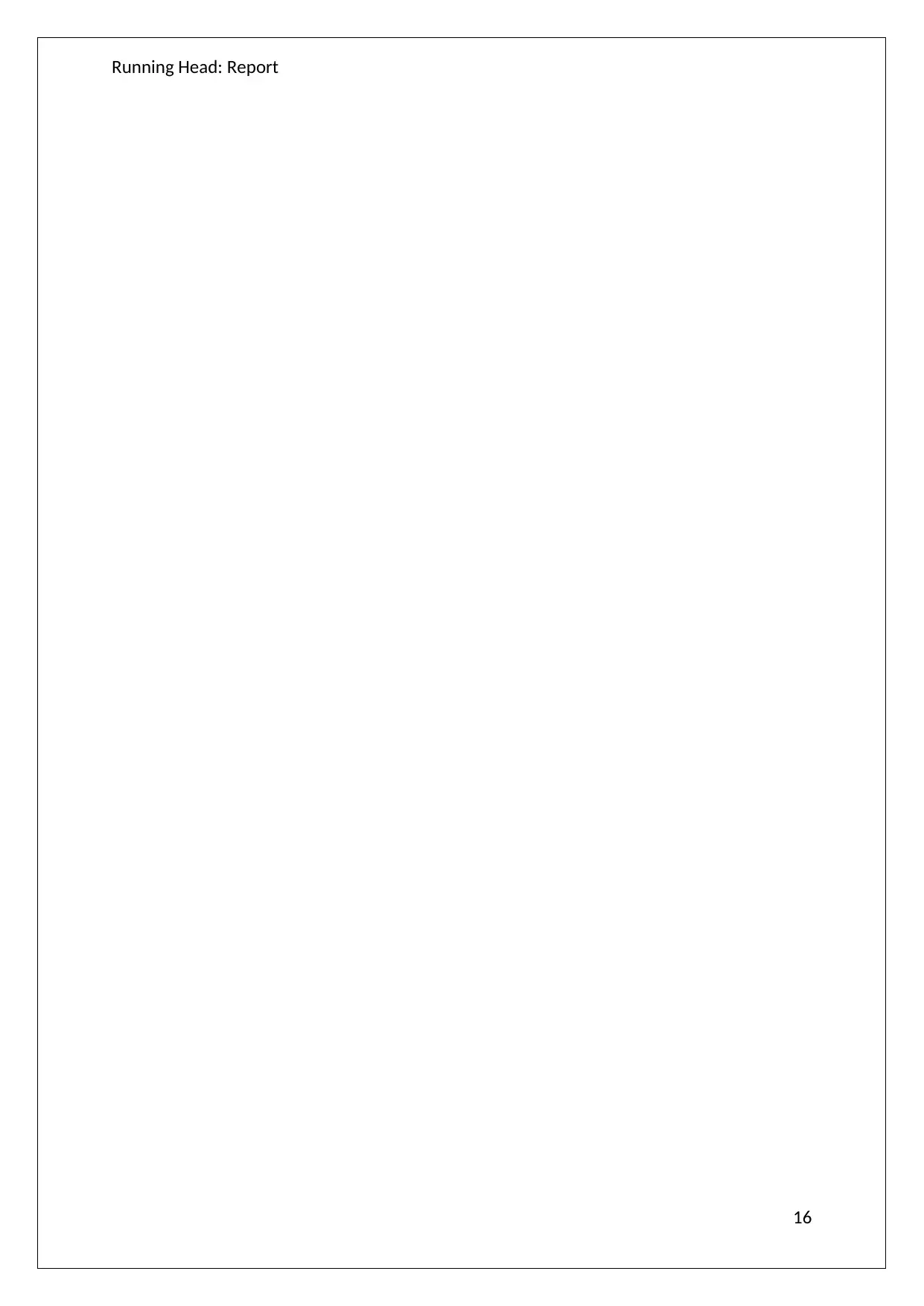
Running Head: Report
16
16
1 out of 17
Your All-in-One AI-Powered Toolkit for Academic Success.
+13062052269
info@desklib.com
Available 24*7 on WhatsApp / Email
![[object Object]](/_next/static/media/star-bottom.7253800d.svg)
Unlock your academic potential
© 2024 | Zucol Services PVT LTD | All rights reserved.